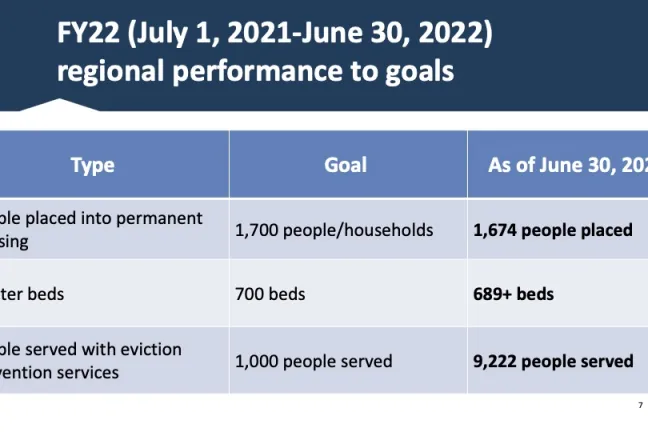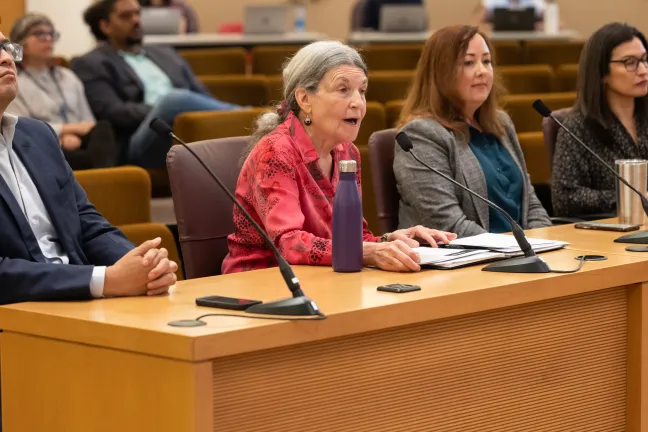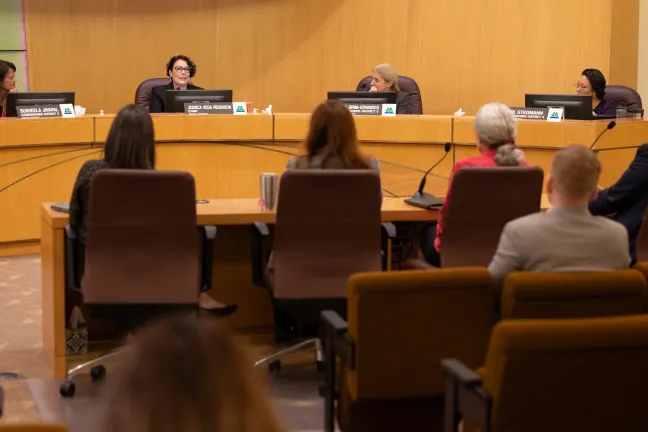At a Board of Commissioners briefing June 20 about the Supportive Housing Services Measure, Metro staff and members of the measure’s independent oversight committee shared a series of recommendations for improving the measure’s rollout regionally — while also expressing hope about the work to come.
The recommendations include addressing ongoing provider workforce shortages, improving data collection, reporting and analysis, and improving communications about the progress already happening in the tri-county area thanks to funding from the measure.
Those efforts are in line with work under way right now by Multnomah County Chair Jessica Vega Pederson and the Joint Office of Homeless Services to improve the County’s spending of Supportive Housing Services dollars and related outcomes.
The recommendations were part of a required annual briefing by the Metro Supportive Housing Services Regional Oversight Committee that also included updates on the initial implementation of the measure and an intense discussion among the Board about what's next.
SHS Oversight Committee makes recommendations for next year
The presenters gave an overview of the history of the measure, which has a 10-year goal to rehouse 5,000 people and provide 10,000 people with eviction prevention services in Multnomah, Washington and Clackamas Counties.
Susan Emmons, co-chair of the oversight committee, hailed some initial successes — particularly in launching programs in Washington and Clackamas Counties, which had very few services before the measure. But she also noted several challenges with the measure’s implementation, and provided the committee’s recommendations for the next year of implementation.
The first recommendation is to increase communication with the community about what’s actually happening with the measure. While the measure has produced many successes — including re-housing nearly 1,700 people and providing eviction prevention services to 9,222 people in its first year of implementation — the oversight committee identified that many community members, including voters who approved the measure in 2020, still don’t realize the difference on the ground.
“As members of the oversight committee, it became clear to us from our colleagues, our neighbors, our friends, our relatives, the people in our community do not understand what is being accomplished with this measure,” Emmons said. “People were judging us by what they saw through their windshields as they drove through our community, and that was all the tents.”
“There's been excellent work done in Multnomah County and the other counties, and we need to tell that story and do it in a collective way,” Emmons said.
The committee also recommended addressing ongoing workforce shortages in the homeless services sector. Providers contracted with the Joint Office of Homeless Services have repeatedly identified workforce challenges as one of the barriers to launching and sustaining programming. Vega Pederson recently announced plans to commit up to $12 million to provider capacity building and organizational health because of these workforce concerns.
“I'd say there's a growing consensus in our community of the critical need to provide a livable wage for the people doing this work. It's difficult work,” Emmons said. “Many of the people in these agencies are passionate about it. But we're not paying a good enough wage.”
Other recommendations included improved data collection, reporting, and analysis, which aligns with the Joint Office’s data-focused work, including efforts to expand on a by-name list of people experiencing chronic homelessness developed through the Built for Zero initiative.
Questions about Supportive Housing Services goals and implementation
Commissioner Lori Stegmann asked about the challenges faced by Multnomah County, which has not met its spending goals for the first two years of the implementation of the measure.
“Could you just give us an overview of what you think the barriers were, and how we're going to move forward?” she asked.
Emmons acknowledged that the underspend is a concern of the oversight committee. Metro and the Joint Office are currently working to finalize a corrective action plan to improve the pace of spending. But Emmons said she’s optimistic, pointing out the paradigm shift and huge set of opportunities the measure created for counties and providers.
“When the measure was adopted, we had a pandemic, and understandably the County and the Joint Office were focused on, ‘Nobody is going to die on our watch.’ We had to reconfigure shelters and rethink transitional housing. It was about safety,” Emmons said. “Then when the money came in, there had to be this pivot. And the pivot probably wasn’t quick enough.”
“But I feel very optimistic and hopeful. Multnomah County has already been a strong presence. You have great providers and I think this will be figured out,” Emmons continued. “You don’t want to just throw the money out. You want it to be deliberate. But I think it will be solved.”
Stegmann also asked about the population the measure focuses on – the measure, as approved by voters, focuses on chronically homeless individuals, which Metro calls “Population A.” Stegmann wondered if the visible homeless population that receives the most attention from the media and residents is the same population that the measure is focused on.
“I'm wondering, do we know of the visibly houseless, how many of those people are the Population A, that are chronically homeless?” Stegmann asked.
Patricia Rojas, Metro’s housing director, confirmed that the bulk of funding from the measure is earmarked to serve that population. In addition, across all three counties, the most recent Point in Time Count showed significant reductions in people counted experiencing chronic homelessness.
“The voters prioritized folks who are experiencing chronic homelessness right now. So that is the work we’re doing,” Emmons said.
But Liam Frost, Metro’s assistant housing director, also noted some persistent misunderstanding about the kind of impact the Supportive Housing Services Measure can have on visible homelessness, even if it successfully helps address chronic homelessness.
Even as the Measure continues to provide housing and shelter for thousands of people, ending their homelessness or helping off the streets, new people take their place every day.
“I think what's often missing in the conversation is the reason why you see more people outside. And that is more and more people are losing their homes. That’s just basic facts” Frost said. “And that will continue as long as we are not creating the conditions for naturally occurring affordable housing.”
Frost said that while programs like the Supportive Housing Services Measure, the Portland Housing Bond and the Metro Housing Bond are all working toward reducing existing homelessness, they won’t, in themselves, won’t stop people from becoming homeless altogether.
“What we're trying to do is to create far more entry points back into permanent housing, whether that's through behavioral health stabilization, recovery, whether through employment services. But ultimately the end destination is a home,” Frost said. “So that's our focus. But if we're talking about our focus in a vacuum, we're not addressing that mismatch. And I think we all have to do a better job talking about the holistic effort as we see it.”
Emmons noted that the goal of the measure isn’t, by itself, to solve all homelessness in the region. Per the language in the measure, she said, “The 10-year plan is to house permanently 5,000 households. And so this plan really was never intended to end all homelessness in our region,” Emmons said. “It was to take a big bite out of it, to address it with a very specific population.”
Commissioner Julia Brim-Edwards said that many voters might be disappointed by the fact that the measure won’t totally resolve an unmet need for permanent housing in the region. “Because of increased inflow,” even if the Measure reaches its housing goal, she said, “there could still be a larger number than 5,000 in need of permanent housing. Is that how I'm reading it? Because I think people thought that this was going to be the solve for the people who didn't have permanent housing.”
”This resource is flexible and allows us to be flexible and responsive in the moment,” Emmons said. “I feel very confident that we're going to reach that 5,000 goal in terms of housing placement and we will go above and beyond that to the extent possible.”
Emmons also urged other jurisdictional partners to join the counties in delivering on the measure’s opportunities. She said some agencies, including the City of Portland, see housing construction as the only means to address inflow amid higher housing costs.
But vouchers funded by the measure “are meant to be used in existing housing. So the idea is you don’t always have to build. You use rent assistance,” she said. “Multnomah County has other rent assistance programs, and there’s more money coming from the State of Oregon. So how do we use those vouchers … and attach them to housing that already exists?”
Commissioner Susheela Jayapal emphasized that expectations about the measure have to be realistic.
“Inflow is beyond the capacity of the SHS measure to address. Susan, you said the SHS measure was never intended to solve homelessness, it was intended to take a big bite out of it,” Jayapal said. “And the thing it's taking a bite out of has just gotten larger over the last three years. Then there's the overlapping of other crises — the drug crisis, and mental health crisis — that are also not intended to be solved by the SHS measure, not to be solved by the counties even. That really has to be a state and federal intervention.”
“So we deservedly talk about the SHS measure. But I think we often talk about it as if it is the whole system, and it is not the whole system,” Jayapal continued.
Chair Vega Pederson echoed that sentiment.
“The baseline of where we were in 2019 when this measure was being created is different than the baseline of where we are today in 2023,” Vega Pederson said, saying that the measure must be used in conjunction with other work to solve the interconnected crises in the region, including improved behavioral health and housing systems, and increased involvement with the state and federal governments.
“I look forward to, as the county chair, continuing to work with Metro about not just the work that's happening in Multnomah County, but about the work that's happening region-wide for the Supportive Housing Services measure. So we really can be getting the most out of it that we can, through all of the work that's going on in the region,” she said.



